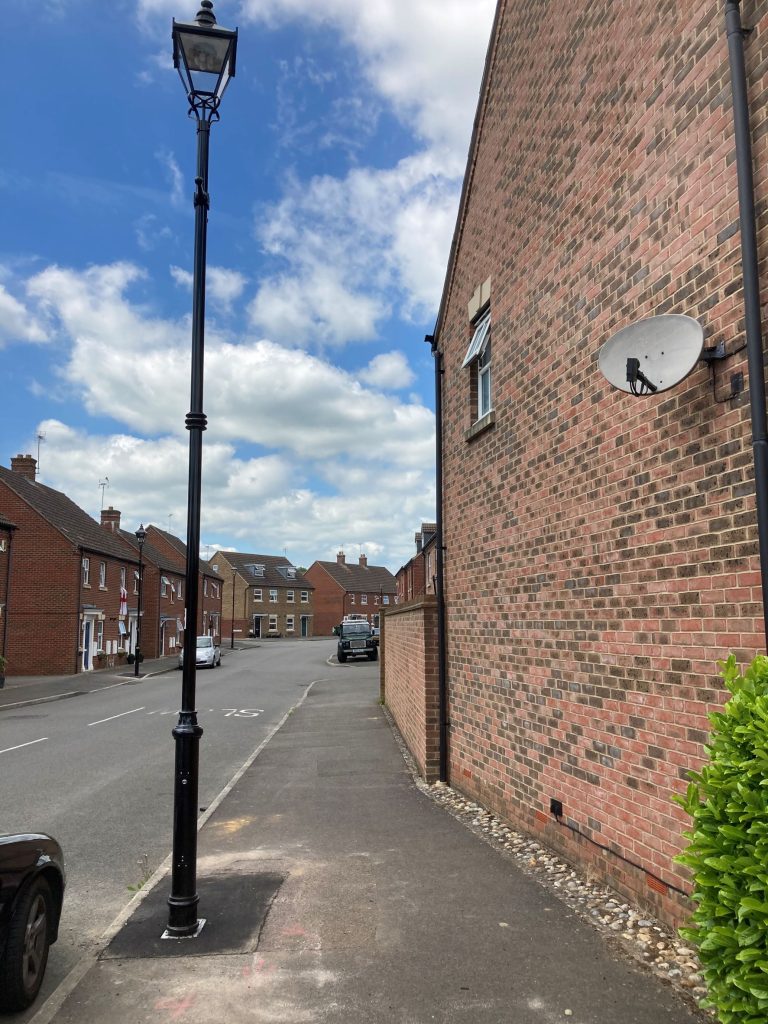The UK’s National Infrastructure Strategy sets out plans to transform UK infrastructure to support levelling up and help meet net-zero emissions by 2050. As part of this strategy, local councils were invited to bid for funding for infrastructure projects that would contribute towards meeting these objectives. One successful application was from Buckinghamshire Council, who secured funding from the UK Government under the ADEPT program to install new Victorian-style lamp posts in a selected area of Aylesbury, Buckinghamshire. When the council needed help in designing and manufacturing new innovative lamp posts for the project, it called on specialist composites manufacturer, Exel Composites to help.
Victorian-style lamp posts are strongly associated with the area of Aylesbury and the council wanted any new infrastructure to retain this aesthetic to help preserve the area’s heritage. At the same time, the council wanted to ensure that next generation, lightweight, and low maintenance materials were installed to ensure the longevity of the infrastructure.
The requirement for the lamp posts was that they had to be Victorian-style in aesthetics and comply with ISO EN40 – Lighting Columns, which is the European design standard. The system also had to be modular, with a design that could vary in size, which is not possible with traditional steel lamp posts that are made in specific heights. It must also be lightweight, facilitating rapid installation times and minimizing road closures. It was desirable for the system to come equipped with electric vehicle (EV) charging capabilities.
Upon successfully winning funding for its project, Buckinghamshire council discovered that its intended manufacturing partner could not deliver the desired Victorian-style lamp posts as it was a fabrication company that does not produce original products. This meant that it had to find a new manufacturing partner to move forward with. This is where Exel Composites came in, who proposed using composites to construct the main body of the lamp posts.
Exel Composites’ UK Project Manager John Hartley explained, “When we began speaking to Buckinghamshire Council’s team about helping it deliver its new lamp post system, we started by conceptualising how the component parts would be designed. We opted for composite tubes manufactured using pull-winding. This manufacturing process allows us to align fibers at angles against the longitudinal direction to meet the desired overall mechanical properties. The tubes could then be joined together to make lamp posts of varying heights.
“The composite tubes were manufactured at our factory in Finland and shipped to our facility in Runcorn, UK where the machining, fabrication and assembly took place. The majority of the ancillary items, which made up roughly six per cent of the final lamp post structure, were moulded, however, a number of these were 3D printed, as we wanted to evaluate this technology for future use. Currently the cost for manufacturing via this route in prohibitively expensive for mass production. However, as the technology evolves, it could potentially become a viable alternative.
The Victorian-style lanterns used in the lamp post system were modified by lighting infrastructure specialist, enLIGHT to be fully remote controlled using a cloud-based system. Furthermore, each lamp post has its own unique GPS reference, so they can be remote controlled on an individual basis.
Hartley continued, “As existing software available commercially was too inflexible to meet our needs, we developed our own spreadsheet calculations for evaluating the performance and to validate that the proposed design would meet the ISO EN40 requirements. Furthermore, finite element analysis was undertaken, this allowed us to validate our computerizations worked and highlight any local stress markers that might occur on the lamp post. Finally, we had the Lamp posts tested and certified at Lloyds British Testing.
“We modelled all our designs using 3D CAD modelling, with all amends reviewed and approved by the council’s team. With an agreed design that was validated using our spreadsheet and FEA analysis, we could develop a prototype lamp post, which we presented to the council’s team. We then went through a review process, which involved a few minor amends to the design, such as making it slimmer to match more closely the existing steel lamppost at the finally selected designated installation location, before producing a final lamp post that met all the council’s requirements, including the desired add-on of built-in EV charging capabilities.
“While the composite solution we provided does not compete with traditional steel lamp posts in terms of cost on a like-for-like basis, there are advantages in terms of total cost of ownership. Despite the higher upfront costs, the modular composites lamp posts are faster and easier to install and require less ongoing maintenance, which means ongoing costs are significantly reduced.
“Exel Composites has now overseen the installation of all of the 170 agreed lamp posts in the area and have entered the monitoring and evaluation period, which will finish in 2023” concluded Hartley.
Ian Frazer Fox, Street Lighting Manager at Buckinghamshire council, added, “Exel Composites was able to create an innovative composite lamp post system that met all our requirements while preserving the Victorian aesthetic that the area is known for.
“Working through COVID-19 lockdowns limited in-person meetings, but Exel’s team kept us updated on a weekly basis, with regular review meetings taking place using Microsoft Teams and Monday.com for saving and sharing all relevant files and documentation. While there is nothing planned for the immediate future, we would be more than happy to engage Exel’s services again on any future infrastructure projects that may arise,” concluded Fox.
To find out more about Exel Composites’ expertise in infrastructure applications, visit https://exelcomposites.com/composite-solutions/composites-in-infrastructure-applications/.

Building, Design & Construction Magazine | The Choice of Industry Professionals





